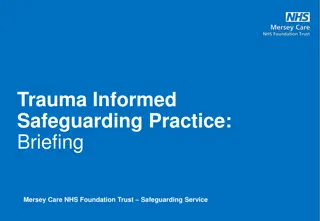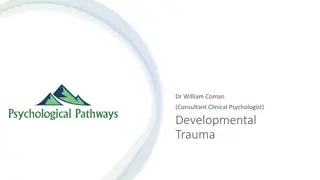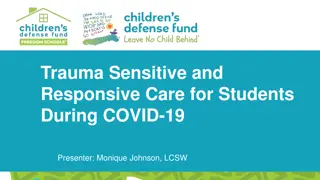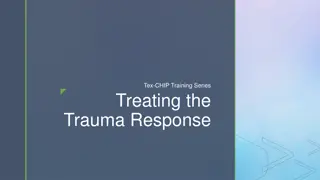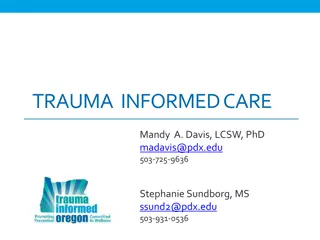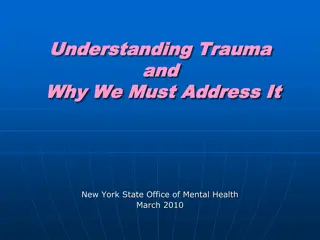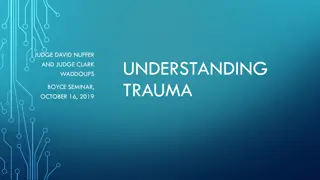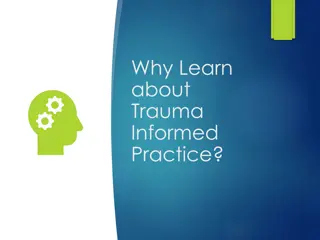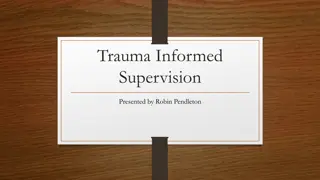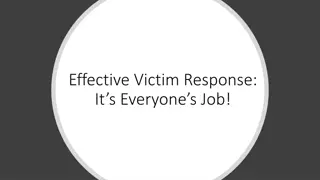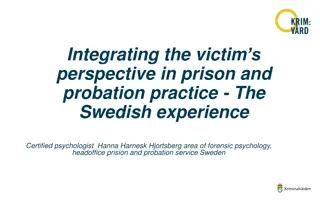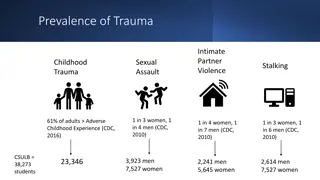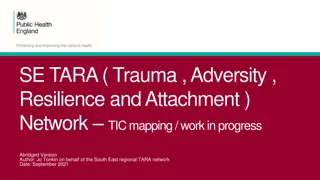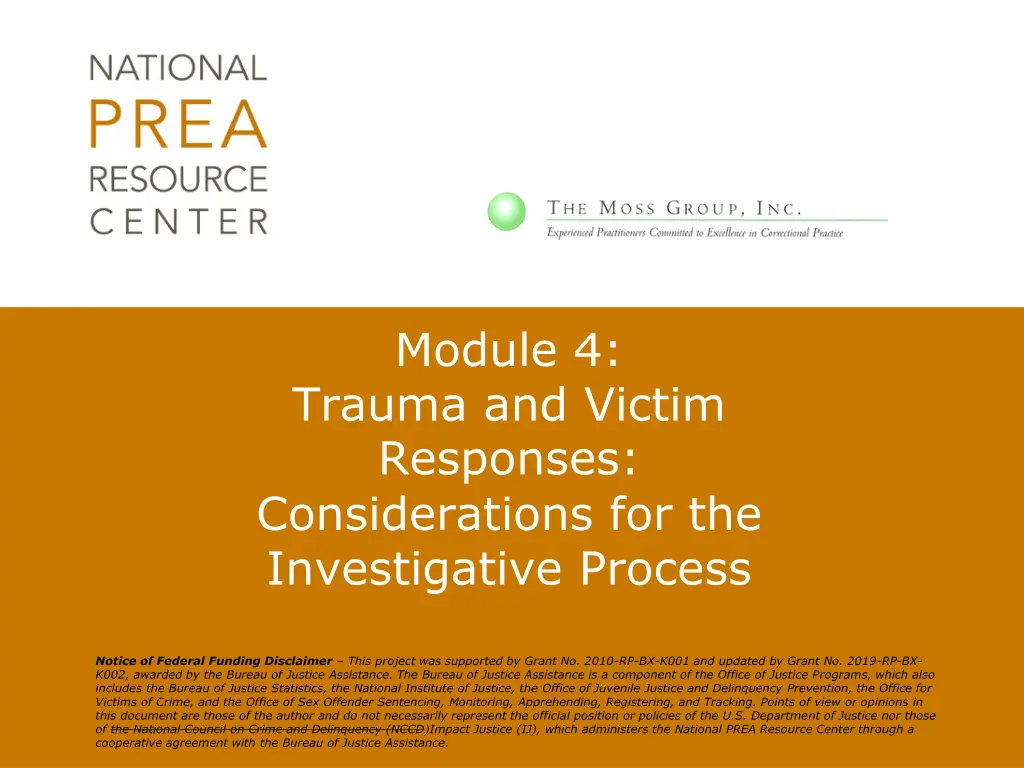
Understanding Trauma: Impact on Victims and Investigative Considerations
Explore the profound effects of trauma on individuals' mental and physical health, the importance of being trauma-informed in investigations, and the neurobiological aspects of trauma on the brain. Learn why understanding trauma is crucial for effective interactions with survivors.
Download Presentation

Please find below an Image/Link to download the presentation.
The content on the website is provided AS IS for your information and personal use only. It may not be sold, licensed, or shared on other websites without obtaining consent from the author. If you encounter any issues during the download, it is possible that the publisher has removed the file from their server.
You are allowed to download the files provided on this website for personal or commercial use, subject to the condition that they are used lawfully. All files are the property of their respective owners.
The content on the website is provided AS IS for your information and personal use only. It may not be sold, licensed, or shared on other websites without obtaining consent from the author.
E N D
Presentation Transcript
Module 4: Trauma and Victim Responses: Considerations for the Investigative Process Notice of Federal Funding Disclaimer This project was supported by Grant No. 2010-RP-BX-K001 and updated by Grant No. 2019-RP-BX- K002, awarded by the Bureau of Justice Assistance. The Bureau of Justice Assistance is a component of the Office of Justice Programs, which also includes the Bureau of Justice Statistics, the National Institute of Justice, the Office of Juvenile Justice and Delinquency Prevention, the Office for Victims of Crime, and the Office of Sex Offender Sentencing, Monitoring, Apprehending, Registering, and Tracking. Points of view or opinions in this document are those of the author and do not necessarily represent the official position or policies of the U.S. Department of Justice nor those of the National Council on Crime and Delinquency (NCCD)Impact Justice (IJ), which administers the National PREA Resource Center through a cooperative agreement with the Bureau of Justice Assistance.
What Does Being Trauma Informed Mean? Being trauma-informed is being sensitive to the impact of trauma, and to the needs of people suffering from trauma. SOURCE: Pamela S. Hyde, Administrator, Substance Abuse and Mental Health Services Administration 3
Why Does Trauma Matter? Serious, short- and long-term impacts on mental and physical health Impacts reporting and interactions with investigators. A high percentage of inmates/residents have experienced trauma in their lives prior to incarceration Investigators working in corrections need to be aware of the impact of trauma on the current mental and physical health of trauma survivors to be able to understand and work with them safely and effectively. 4
Neurobiology of Trauma Trauma has been proven to have significant and very real effects on the victims and their brain functioning Disrupts the stress-hormone system that is regulated by the brain Stays stuck in the brain s subconscious (limbic system, brain stem, etc.) where they are inaccessible by the conscious areas (frontal lobe, etc.) Can result in Post Traumatic Stress Disorder
Neurobiology of Trauma Limbic Frontal Lobe Brain stem
Trauma and the Brain Frontal lobe: seat of conscious memory, chronological information Limbic system: controls emotion, fear response, sensory memories Brain stem: controls instinctive reactions (fight/flight/freeze)
Limbic System Controls the senses, emotions Includes amygdala, hippocampus During a traumatic event, amygdala might depress hippocampus function and make an individual unable to remember all or part of the events Traumatized individuals might be more able to answer sensory questions than ones about the specific events: What did you see? What did you hear? What did you taste? NOT: What happened?
Frontal Lobe Responsible for conscious memory and verbal skills Helps an individual put events in order Takes time after a traumatic event may make the interviewee unable to recall events accurately soon after trauma During trauma this can become dissociated from the rest of the brain, preventing a victim from remembering or preventing them from speaking about their memories
Trauma and the Brain: What does this mean for investigators? Victims of trauma may have incomplete or imperfect memories of the events surrounding their trauma, or may only recall events with time Cognitive interviewing focusing first on the sensory experience (touch, taste, smell, hearing) can help an interviewee to remember Recalling traumatic events may re-trigger the emotional parts of the brain and force the victim to relive aspects of the trauma. Be sensitive to this during the interview process.
Implications: How to be Trauma Informed A trigger is something that sets off an action, process, or series of events (such as fear, panic, upset, agitation) because a trauma survivor experiences a traumatic memory. Why is it important to understand triggers? To understand why an inmate/resident may respond in a certain way to your appearance / demeanor / actions and, if possible, avoid that response. To better reconstruct the events that occurred during an alleged incident of sexual abuse. SOURCE: Creating Trauma Informed Systems of Care for Human Service Settings: What is Trauma and Why Must We Address It? by Joan Gillece, PhD
PERCENTAGE OF INMATES REPORTING CHILDHOOD PHYSICAL ABUSE FEMALE VS. MALE 100% 90% 80% 70% 60% Men Women 50% 40% 30% 20% 10% 0% Childhood Physical Victimization Source: Patterns of Victimization Among Male and Female Inmates: Evidence of an Enduring Legacy, Violence and Victims, 2009 By: Wolff, Nancy; Shi, Jing; Siegel, Jane A.
PERCENTAGE OF INMATES REPORTING CHILDHOOD SEXUAL ABUSE FEMALE VS. MALE 100% 90% 80% 70% 60% Men Women 50% 40% 30% 20% 10% 0% Childhood Sexual Victimization Source: Patterns of Victimization Among Male and Female Inmates: Evidence of an Enduring Legacy, Violence and Victims, 2009 By: Wolff, Nancy; Shi, Jing; Siegel, Jane A.
Impact of Sexual Abuse Incidents of sexual abuse are destructive, catastrophic, life- changing events. While each victim responds uniquely, victims are likely to experience problems that are: physical emotional cognitive psychological social sexual SOURCE: Dumond, R.W. & Dumond, D.A. (2007a). Managing prison sexual violence: A guide to effective victim services. Building Blocks for Institutional Safety. Denver, CO: Colorado Department of Public Safety, Division of Criminal Justice, Office of Research & Statistics.
Impact of Sexual Abuse What you may see from the victim -- within hours of abuse: Being very expressive: Appearing hysterical and/or verbalizing feelings of sadness or anger. Displaying a range of feelings, including crying, sobbing, smiling, restlessness, tenseness, & joking. Appearing distraught or anxious; expressing rage or hostility against those attempting to care for them. . Remaining controlled, numb, in shock & disbelief: Masking or hiding feelings behind a calm, composed, or subdued effect. Presenting themselves in a flat affect, quiet, reserved manner. Having difficulties expressing themselves. SOURCE: Dumond, R.W. & Dumond, D.A. (2007a). Managing prison sexual violence: A guide to effective victim services. Building Blocks for Institutional Safety. Denver, CO: Colorado Department of Public Safety, Division of Criminal Justice, Office of Research & Statistics.
Impact of Sexual Abuse What you may see from the victim short-term: Phobias -- preoccupation with personal safety, reluctance to leave room/home, fear of being alone, withdrawal from activities or relationships Mood swings -- happy to angry, anxiety, sense of helplessness, irritability or outburst of anger, difficulty concentrating, crying frequently hyper vigilance, exaggerated startle reactions. Denial -- efforts to deny abuse took place and/or minimize impact, avoiding thoughts or activities associated with trauma. Hesitation in forming new relationships. Flashbacks -- intense psychological or physiological distress at exposure to cues associated with the traumatic event. SOURCE: Dumond, R.W. & Dumond, D.A. (2007a). Managing prison sexual violence: A guide to effective victim services. Building Blocks for Institutional Safety. Denver, CO: Colorado Department of Public Safety, Division of Criminal Justice, Office of Research & Statistics.
Impact of Sexual Abuse Victims may negatively cope with their victimization in the long-term by: Dulling their senses with substances. Acting out their pain by re-victimizing others within the correctional institution or in the community. Being self-destructive. Displaying anger towards the offender, legal system, family/friends Displaying hyper vigilance to danger. Being fearful of new & risky situations. Experience sexual dysfunction, engaging in sexual behavior, but with decreased or increased enjoyment and arousal. Engaging in sexually promiscuous and/or aggressive behavior. Remember you may encounter victims at all stages depending on when they came forward to report the abuse! SOURCES: Dumond & Dumond, 2002; Lockwood, Daniel. (1980). Prison Sexual Violence. New York: Elsevia/Thomond Books and Wooden, WS & Parker, J. (1982). Men behind bars: Sexual exploitation in prison. New York: Plenum Press.
Impact of Sexual Abuse: Corrections Incarcerated sexual abuse victims: May experience repetitive assaults by multiple assailants over a period of time. This may lead to: Ongoing physical and psychological trauma, A more debilitating form of PTSD. Incarcerated victims may also experience: A loss of social status, and Increased vulnerability within the jail or prison, Additional feelings of betrayal, alienation and violation, which increases pain and suffering in cases of staff sexual misconduct. SOURCE: A Guide to An Effective Medical Response to Prisoner Sexual Violence {Monograph for Colorado Department of Public Safety Dumond & Dumond, 2007}
Impact of Sexual Abuse: Men In addition to the previously discussed symptoms, male victims May experience erection and orgasm during anal rape due to the pressure on the prostate, which compounds the trauma and exacerbates self-blame. Often experience concern about their masculinity, competence and security, which increases their humiliation and suffering. Often manifest a more controlled response, which may lead authorities to conclude the events did not occur or to minimize its impact. SOURCE: A Guide to An Effective Medical Response to Prisoner Sexual Violence {Monograph for Colorado Department of Public Safety Dumond & Dumond, 2007}
Impact of Sexual Abuse: Women In addition to the previously discussed symptoms, incarcerated female victims: Have a much higher rate of physical and sexual victimization during childhood, adolescence and prior to their incarceration, resulting in increased vulnerability to PTSD. Have histories of abuse and submission reinforce feelings of inadequacy, despair and unworthiness. May experience compounded expectations of betrayal and anger resulting from incest victimization during childhood in cases of staff sexual misconduct. SOURCE: Dumond, R.W. & Dumond, D.A. (2007a). Managing prison sexual violence: A guide to effective victim services. Building Blocks for Institutional Safety. Denver, CO: Colorado Department of Public Safety, Division of Criminal Justice, Office of Research & Statistics.
Implications What does this mean for investigations? Understanding the background, history, and the potential for ongoing trauma and mental health issues will allow investigators to: Better understand inmates /residents actions, reactions and interpretations of events. Better reconstruct inmates /residents actions and reactions. Positively impact the healing process of inmates/residents who have recently experienced trauma through sexual abuse. 23
Implications: How to be Trauma Informed Do no harm in your interactions with victims. Be aware of your power to cause a second injury, through: Perceived rejection/disbelief Perceived indifference, or lack of support Projections (conscious or unconscious) of blame on the victim Be aware of your power to discourage reporting and cooperation, which may result in: A loss of crucial information in a case, A decrease in facility safety, and Increased agency liability. SOURCE: Dumond, R.W. & Dumond, D.A. (2007a). Managing prison sexual violence: A guide to effective victim services. Building Blocks for Institutional Safety. Denver, CO: Colorado Department of Public Safety, Division of Criminal Justice, Office of Research & Statistics.
Implications: How to be Trauma Informed Be aware of reasons victim reporting is often delayed: Fear, guilt, shame. Assumption of agency disbelief. Expectations that they will be placed in protective custody, segregation, or transferred. Fear of being labeled a homo or punk or snitch. Fear of further victimization. Idea that inmates/residents cannot be real victims or that inmate/resident victims deserve their fate. Do NOT make assumptions around a report s validity exclusively based on how long ago the alleged incident occurred or the reasons an alleged victim gives for delaying the report. SOURCE: Dumond, R.W. & Dumond, D.A. (2007a). Managing prison sexual violence: A guide to effective victim services. Building Blocks for Institutional Safety. Denver, CO: Colorado Department of Public Safety, Division of Criminal Justice, Office of Research & Statistics.
Implications: How to be Trauma Informed Demeanor: Correction culture tends to encourage a tradition of toughness approach; recognize that certain culture and practices can be re- traumatizing Stay calm and emphasize a listening role when discussing sensitive issues with survivors Sexual abuse victims suffer from disempowerment. Consider steps you can take re: your body language, tone of voice, uniform, etc. to create a more comfortable environment for the inmate. SOURCE: Creating Trauma Informed Systems of Care for Human Service Settings: What is Trauma and Why Must We Address It? by Joan Gillece, PhD In Their Own Words, Maine Trauma Advisory Group Report, 1997
Implications: How to be Trauma Informed Language: Emphasize collaboration rather than compliance. Trying to pressure the alleged victim into talking will only delay the investigation. Be aware of the implications of what you ask: What happened to you? vs. What s wrong with you? Don t condescend to the victim: Nobody can hurt you now. Trust me. SOURCE: Creating Trauma Informed Systems of Care for Human Service Settings: What is Trauma and Why Must We Address It? by Joan Gillece, PhD In Their Own Words, Maine Trauma Advisory Group Report, 1997
Implications: How to be Trauma Informed Location: Incarcerated victims of sexual abuse can face potentially dangerous consequences if their victimization becomes general knowledge labeling the victim can be catastrophic. Providing privacy to alleged victims during the interview process will create a more comfortable environment in which the inmate/resident may be more likely to share important information with the investigator Consider how your choice of interview locations may impact the quality of your interview. SOURCE: Dumond, R.W. & Dumond, D.A. (2007a). Managing prison sexual violence: A guide to effective victim services. Building Blocks for Institutional Safety. Denver, CO: Colorado Department of Public Safety, Division of Criminal Justice, Office of Research & Statistics.
Implications: How to be Trauma Informed Response: Understand unexpected/irrational behavior as adaptive rather than seeing it as intentionally provocative: Rage Repetition-compulsion Self-injury Remind yourself that these behaviors result from trauma; Traumatized adults respond to their trauma history in the present. Don t take things personally. SOURCE: Creating Trauma Informed Systems of Care for Human Service Settings: What is Trauma and Why Must We Address It? by Joan Gillece, PhD In Their Own Words, Maine Trauma Advisory Group Report, 1997
Implications: How to be Trauma Informed An investigator could trigger an inmate/resident simply by looking like a past attacker. Visual triggers include: Sex Hair color Height Mannerisms Race How should this knowledge impact investigations? SOURCE: Trauma Addictions Mental Health and Recovery (TAMAR) Treatment Manual and Modules
Implications: How to be Trauma Informed 1. Recognize the existence and impact of trauma. 2. Do no harm in your interactions with victims. 3. Work intentionally to incorporate your knowledge of the existence and impact of trauma into your investigation techniques.




